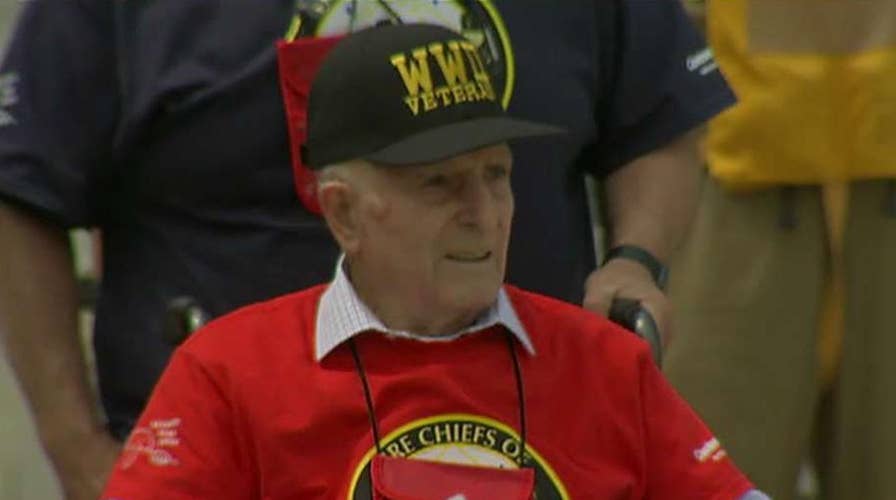WWII veterans mark 75th anniversary of the Battle of Midway
Wreath-laying ceremony held in D.C.
Editor’s Note: Sunday marked the 75th anniversary of the Battle of Midway, which took place June 4-7, 1942.
It was one of those military encounters that could easily have gone either way. The turning point played out over a few minutes in the North Pacific near a tiny coral atoll named Midway. This decisive naval battle 75 years ago not only changed the course of World War II, but also established the aircraft carrier as the principal strategic weapon of the United States Navy.
Midway wasn’t much of a place. Two tiny islands crisscrossed by airstrips totaled barely 1,500 acres on the edge of a lagoon circled by a jagged reef. But in 1942, Midway may have been the most heavily defended acreage in the Pacific.
Six months after Pearl Harbor, intelligence garnered by Allied code breakers discerned three possible Japanese offensives in the Pacific: an invasion of Alaska’s Aleutian Islands to cover Japan’s northern flank; a thrust into the Southwest Pacific to sever West Coast-to-Australia supply lines; and a strike toward Hawaii to extend Japan’s defensive perimeter by seizing Midway and in the process destroying what remained of the American fleet. Based on canny analysis, Admiral Chester W. Nimitz, commander in chief of the US Pacific Fleet, judged the latter the most likely.
Midway wasn’t much of a place. Two tiny islands crisscrossed by airstrips totaled barely 1,500 acres on the edge of a lagoon circled by a jagged reef. But in 1942, Midway may have been the most heavily defended acreage in the Pacific. After Admiral Nimitz flew 1,100 miles from Pearl Harbor to inspect its defenses, he left with a sense that the island could be held—if he could find the approaching Japanese fleet. Nimitz chose to marshal his three remaining aircraft carriers, one badly mauled just weeks before, together into one powerful offensive force—something that had not been done before—and wait for an opportunity to pounce.
Intercepting Admiral Isoroku Yamamoto’s armada in an expanse of ocean would not be easy, particularly given changing weather conditions and the limitations of aerial reconnaissance. Yamamoto deployed 162 ships in support of the Midway operation: a strike force of the aircraft carriers, Akagi, Kaga, Soryu, and Hiryu; an occupation force in twelve transports; and Yamamoto’s main battleships and cruisers. Finally, there was a northern force of two carriers, cruisers, and transports, sailing toward Alaska.
Under Nimitz’s orders, Rear Admiral Raymond Spruance departed Pearl Harbor on May 28 with the carriers Enterprise and Hornet. Two days later, after a frenzied three-day effort to repair battle damage from Coral Sea, Yorktown followed, flying Rear Admiral Frank Jack Fletcher’s flag. Fletcher would assume overall command when the two forces joined up northeast of Midway at a point Nimitz optimistically called “Point Luck.”
Yamamoto planned to attack the Aleutians and Midway simultaneously on June 3 in a double-fisted punch designed to lure the American fleet into one pitched battle whether it steamed north to rescue the Aleutians or west to support Midway. But as Enterprise, Hornet, and Yorktown lurked near Point Luck, Nimitz refused to take the Aleutians bait even after the Japanese attack on Midway fell a day behind. On the morning of June 4, his patience was rewarded.
Search planes found the four Japanese carriers. Fletcher ordered strikes from Enterprise and Hornet, but the American fliers scored no hits. Japanese fighter defenses were formidable. One squadron of aging Douglas TBD Devastator torpedo bombers launched from Hornet lost all fifteen of its planes and their crews except for one pilot who ditched and was rescued.
Four Japanese carriers that had made the attack on Pearl Harbor and 257 of their planes, along with thousands of men, were sunk or sinking. Stunned at the loss of his air superiority, Admiral Yamamoto turned his battle force around.
Long minutes later, the moment of luck occurred for the Americans. Squadrons from Enterprise and Yorktown found the Japanese carriers at the very moment their planes were on deck refueling and re-arming after strikes against Midway. In seconds, three of the carriers were in flames. Dive-bombers from the surviving Hiryu took off and pummeled Yorktown, but by late afternoon a squadron from the Enterprise and surviving planes from Yorktown sank the Hiryu.
When the sun set in the North Pacific on June 4, 1942, Yorktown was crippled for good, but four Japanese carriers that had made the attack on Pearl Harbor and 257 of their planes, along with thousands of men, were sunk or sinking. Stunned at the loss of his air superiority, Admiral Yamamoto turned his battle force around. Midway would remain in American hands, but there was much more.
“The Battle of Midway,” Nimitz’s boss, Admiral Ernest J. King, proclaimed, “put an end to the long period of Japanese offensive action and restored the balance of naval power in the Pacific.” Midway was, as historian Walter Lord characterized it, an “incredible victory” for the United States. Nimitz reiterated the goal of defeating Japan, but couldn’t resist injecting a pun into his battle report. “Perhaps,” he wrote, “we will be forgiven if we claim that we are about midway to that objective.”

